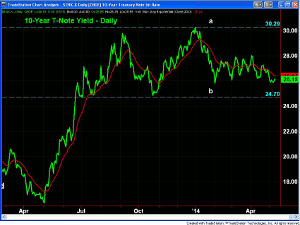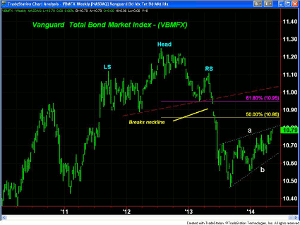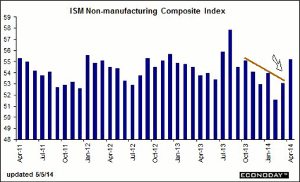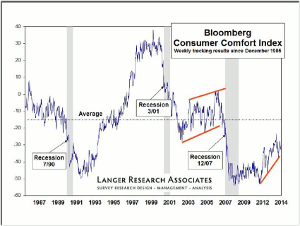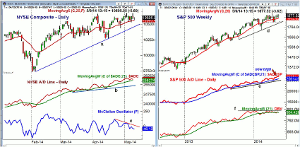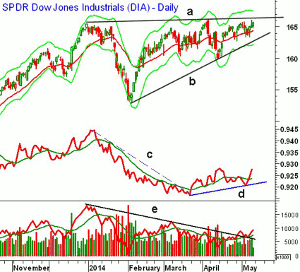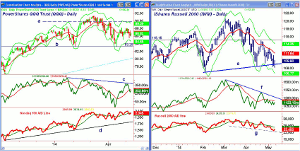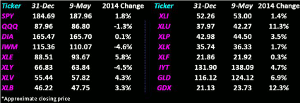It certainly has been a wild time in the markets lately, with last year’s outperformers such as technology getting hammered, while laggards such as utilities surging. And MoneyShow’s Tom Aspray tries to make sense of yet another confounding phenomenon, the decline in interest rates in an improving economy.
It has been a rough few months in the stock market especially after the steady rise of stock prices in 2013. At the end of last year, it was my view that 2014 would be a more difficult market, but so far, it has been even choppier than I thought it would be.
The investment pros, as measured by hedge fund performance, have also had a tough time, with negative returns in both March and April. Global hedge fund assets rose to a new record in the 1st quarter, but I would imagine some of those investors are having second thoughts.
The decline in interest rates in 2014 has also been a surprise to many especially in the past few weeks as the economic data, including the sharply higher employment numbers, would typically cause rates to move higher.
The yield on the 30-year T-bond has fallen from the December 31 close of 3.964% to 3.415% early Friday. The yield on the 10-year T-note closed 2013 at 3.026% and is now at 2.618%. So is this the start of a new bond bull market as some are predicting?
In my opinion, one of the key advantages that technical analysis has over fundamental analysis is that technical analysis will generally give you clear signals when you are wrong. At the end of May 2013, I pointed out that both the 30-year and 10-year yields had completed significant bottom formations.
The reverse head-and-shoulders bottom formations generally occur at major bottoms and that interpretation of the 10-year T-note yield chart has not changed. The daily chart shows the rise from a yield of 1.631% on May 1 to a high of 3.026% at the end of the year.
The yield on the 10-year hit a six-month low on Monday before rebounding. The yield has been in a trading range (lines a and b) for many months, which after the sharp rise in yields is not surprising. Therefore, this still appears to be a pause in the uptrend or a continuation pattern.
It is my view that the gradual decline in yields from March is more likely the result of foreign buying. The conflict in Ukraine and concerns over Russia’s recent action has made many seek the safe haven of the US Treasury market.
Hedge funds and traders are betting heavily that bond prices will drop and rates will rise. The net short position has risen $285 billion or 33% since the end of 2013. This suggests that rates may need one more spike to the downside in order to squeeze the shorts. They are also betting heavily on the long side of bonds last May before they dropped sharply.
A weekly close in the 10-year yields below 2.47% would suggest my outlook for rates is wrong, and it should signal a drop to the 2.00% level. The chart of the 30-year T-bond does look quite different but a weekly close in yields below 3.200% would violate the 50% Fibonacci support and suggest that yields could decline towards 3.00%.
I continue to recommend that bond holders use the recent strength in bonds to shorten the maturity of their bond portfolios. Many learned the painful lesson last year that bond funds and ETFs can suffer significant losses when rates move higher. These losses may have offset the dividends for fund holders. That is why individual bonds are favored as they give you a return of your capital when held to maturity.
The chart of the Vanguard Total Bond Market Index (VBMFX) has net assets of over $113 billion and currently yields 2.45%. The weekly chart shows that it also completed a head-and-shoulder top at the end of May.
From the high of $11.25 to the September low of $10.46, the fund dropped just over 7%. The fund is still rebounding and there are no signs yet that the rally is ending. So far, it has not even retraced 50% of the decline from the 2012 highs.
The chart shows what could be a flag formation, lines a and b. If this formation is completed, VBMFX could drop to the $10.35-$10.40 area. This is about 4% below current levels.
Even though the return on high-grade corporate bonds has led the S&P 500 with dividends by over 2%, so far this year, I continue to favor stocks over bonds.
The demand for bonds is a global phenomenon as French company Numericable Group SA set a new record for a junk bond as they are expected to raise $11.6 billion topping Sprint’s prior record of $6.5 billion.
Estimates are that the yield will be between 5.5% and 6.5%. After Mario Draghi’s comments last week, it seems very likely that the ECB will lower rates in June making these yields attractive to some.
NEXT PAGE: What to Watch
|pagebreak|It was a light economic calendar last week, but it started off on a positive note as the ISM Non-Manufacturing survey came in at 55.2. This was well above the consensus estimate of 54.2 and last month’s reading of 53.1. New orders and business activity were strong, though there was no pickup in hiring. The downtrend from last October has been broken.
This week, there is a much fuller economic calendar with Retail Sales, Import and Export Prices, and Business Inventories on Tuesday. It may take a strong number on retail sales to get the retail sector stocks to finally turn higher.
On Wednesday, we get the Housing Market Index, which hopefully will signal a more positive outlook by the builders. Thursday is the big day as besides the weekly jobless claims, there is the Consumer Price Index, Empire State Manufacturing Survey, Philadelphia Fed Survey, and Industrial Production.
The weekly report on the Bloomberg Consumer Comfort Index will also be released Thursday; last week, it was close to a six-year high. The long-term chart shows how it plummeted prior to the last two recessions. It is still in a short-term uptrend but is well below its historic average. Housing Starts and the preliminary reading on Consumer Sentiment from the University of Michigan will be released on Friday.
What to Watch
After the Spyder Trust (SPY) reversed to the upside from Monday’s lows as it had done the prior week, I thought it might finally be able to break out of its range. Instead, we had another week of choppy non-trending action in the major averages though there were plenty of stocks that saw double-digit declines.
Even some of the stocks that met earnings expectations were sold as they didn’t meet the market’s high standard on guidance. A critical look at the daily studies does not rule out a drop below last week’s lows. The strength of the Dow Industrial and Dow Transport is an encouraging sign. The technical studies do not show the patterns that suggest we are ready for a several-month decline.
Though the individual investor was only slightly less bullish at 28.34% there seems to be a few more media bears. The carnage in the hedge-fund industry seems to be quite widespread. According to option expert Larry McMillan, his put/call ratios are split while his analysis of the volatility indices “remains quite bullish.”
The five-day MA of the % of S&P 500 stocks above their 50-day MAs was pretty much unchanged from last week at 53.7%. A drop below the recent lows and the uptrend, line a, will suggest a drop to even more oversold levels.
On the right side, we have the same analysis of the Nasdaq 100 showing that the April drop below 2.2% was an extremely oversold reading. It is the lowest level in over three years. The MA is trying to turn lower, and it could form a pattern of higher lows in the 20% area. This would be similar to what happened in November 2012 (see circle).
NEXT PAGE: Stocks
|pagebreak|The daily chart of the NYSE Composite (NYA) shows Thursday’s spike above the recent highs and then the weak daily close. So far the 20-day EMA is holding. A decline much below 10,530 should signal a test of the uptrend, line a, in the 10,450 area.
The monthly projected pivot support is at 10,373 with the quarterly pivot at 10,270, which corresponds to the April lows. A strong close above 10,680 might be enough to signal a move to the monthly projected pivot resistance at 10,920.
The daily NYSE Advance/Decline made a new closing high with prices on May 2, but has weakened slightly. It is still above its gradually rising WMA, with more important support at line b.
The McClellan oscillator shows a pattern of lower highs, line c, as it had a rally failure after breaking its downtrend. It is only slightly oversold at -46 as it dropped to -149 in April and -198 at the February low.
S&P 500
The weekly chart of the S&P 500 is holding above the 20-week EMA at 1852. This is one of the support zones that many are watching. If it is broken, many are looking for a decisive drop to the April lows at 1814. The monthly projected pivot support for May is at 1833.
The sharp decline in the Spyder Trust (SPY) on Tuesday erased the gains from Monday’s lows and puts us back into the short-term range. It is trying to hold above the monthly pivot at 185.20 with S1 support at $184.78 and the monthly projected pivot support at $183.18.
There is still key resistance at the early-April high at $189.70 with the monthly projected pivot resistance at $192.83. The weekly starc+ band is now at $193.59.
The weekly S&P 500 A/D did make a new high two weeks ago and is still well above its rising WMA. The uptrend from last August’s low, line e, is well below current levels.
The weekly OBV on SPY looks a bit better than the cash as the cash OBV could drop below its WMA this week. Both have a band of resistance, line f, at the recent highs.
Dow Industrials
The SPDR Dow Industrials (DIA) continues to act quite well as it exceeded the early-April high had a new all-time closing high on Friday. I have been expecting the Dow stocks to take over leadership, and it now seems that it is finally occurring. In the Monthly Analysis of the Most Oversold Dow Stocks, I took a look at some that had the most positive long-term charts.
The daily chart has strong resistance now in the $166.40 area with the daily starc+ band at $167.54. The monthly projected pivot resistance is at $169.89 with the weekly starc+ band at $170.12.
The 20-day EMA is now at $164.27 with the monthly pivot a bit lower at $163.71. There is additional support at $162.78, which was the two-week low with the quarterly pivot at $160.30.
The daily relative performance appears to have completed its bottom as it rose sharply last week after breaking its downtrend, line c, in March. The weekly RS line (not shown) is also above its WMA and shows a pattern that also suggests it has become a market leader.
The daily on-balance volume (OBV) broke its downtrend in March, and though it is still lagging the price action, appears to have bottomed. The weekly OBV (not shown) closed last week at a new all-time high and well above its WMA.
Nasdaq-100
The PowerShares QQQ Trust (QQQ) hit a low last week of $85.53, which was below the monthly pivot at $86.78. There is additional support in the $84.50 area. The $83.28 area, line b, has held throughout the year.
The daily on-balance volume (OBV) has dropped below its WMA after testing its downtrend, line c. It does not show a completed bottom formation as it needs to move back above the recent high. The weekly OBV (not shown) has been below its WMA since early April.
The Nasdaq 100 A/D made a new high on Monday and is clearly acting stronger than prices as it is just below its flat WMA.
There is initial resistance in the $87 area and a close above $88.21 would be a positive sign.
Russell 2000
The iShares Russell 2000 Index (IWM) tested the April lows at $108.30 last week but closed above the chart support at line e. The quarterly projected pivot support is at $108.80. The starc- band is at $106.69 with the weekly at $103.82, which is very close to the monthly projected pivot support at $103.22.
There is initial resistance now at $111.81 and the declining 20-day EMA. The monthly pivot is at $113.04 with more important resistance now at $105.15.
The daily OBV is still below its WMA but did not show any increase in volume last week. The weekly OBV closed below its flat WMA last week.
The Russell 2000 A/D shows a pattern of slightly lower lows, line g, and is still well below its WMA.
NEXT PAGE: Sector Focus, Commodities, and Tom's Outlook
|pagebreak|Sector Focus
The iShares Dow Jones Transportation (IYT) traded in a tight range last week but did close higher. It still needs a strong close above the high at $139.45 to signal upward acceleration.
This is the next upside target. The weekly starc+ band is at $143.67 with the monthly projected pivot resistance at $144.15.
The weekly relative performance closed at new highs last week so it continues to be a market-leading sector. It is up 4.8%, so far in 2014, which is almost 3% better than the SPY. As I noted last week, the Aspray’s OBV Trigger (AOT) triggered a buy signal as the OBV has moved further above its WMA.
The monthly pivot is at $135.97 with the three week low at $134.45.
The Spyder Trust (SPY) gave up some of its gains last week while the SPDR Dow Industrials (DIA) moved into positive territory. The PowerShares QQQ Trust (QQQ) is now down 1.4% while the iShares Russell 2000 Index (IWM) is even weaker now down 5.4%%.
Despite the sharp declines in many individual stocks, there were quite a few of the sector ETFs that did close the week higher. This includes the Select SPDR Materials (XLB), Select SPDR Industrials (XLI) and Select SPDR Consumer Staples (XLP). The XLP closed on the week’s high and at convincing new highs for the year.
The Select SPDR Utilities (XLU) are still the best sector for the year but closed the week on the lows. I mentioned two weeks ago that a correction was likely.
The Select SPDR Health Care (XLV) is up just 4.0% for the year while the Select SPDR Financials (XLF) is just barely positive.
In last week’s What Are the Rich Buying?, I recommended the Select SPDR Consumer Discretionary (XLY). The daily OBV is positive but it needs to move above the $64.70 level to complete a short-term bottom.
Crude Oil
Crude oil traded in a narrow range and closed the week just a bit higher. The weekly OBV is still positive. Crude is holding above the quarterly pivot at $97.57.
Precious Metals
The SPDR Gold Trust (GLD) and the Market Vectors Gold Miners ETF (GDX) both closed the week lower as they reversed course after the comments from Fed Chair Janet Yellen.
The weekly OBV needs a much stronger close to complete is bottom and support my recent buy recommendation.
The Week Ahead
Watching the stock market last week made me feel like I was in a small boat on a rough ocean. The intermediate-term outlook remains bullish and the best bet still seems to be the high-yield large-cap stocks. There are no signs yet, despite the new closing high in the Dow Industrials, that the period of choppy trading is drawing to a close.
We are still somewhat nervously long both the Spyder Trust (SPY) and PowerShares QQQ Trust (QQQ). If the QQQ gets back to its recent lows I still like it.
The Vanguard Emerging Markets (VWO) continues to look positive but it needs to have a further pullback to set up a good entry point. I would not be buying bonds at these levels and favor higher-yielding stocks with growth potential. I still have several open orders in some of the Dow stocks.
Also, I would continue to stay with the dollar cost averaging positions in the S&P 500-tracking ETF that I discussed in the January 24 column, A Path to Investing Success in 2014.
Those who were not in the market should have started a dollar cost averaging plan on April 11 as the S&P 500 had closed below 1830 the previous day. Another equal purchase should have been made on April 25 and again on May 2. The program should be completed by one more equal dollar amount purchase next Friday, May 16.
Now that the earnings season is drawing to a close, the market may calm down a bit so we are keeping some powder dry for when the market starts trending again. Continue to monitor your portfolio each weekend, and if you are still long any of the stocks that have been beaten down, develop a plan or strategy to manage the positions.
Don't forget to read Tom's latest Trading Lesson, My Four Favorite Research Sites.

